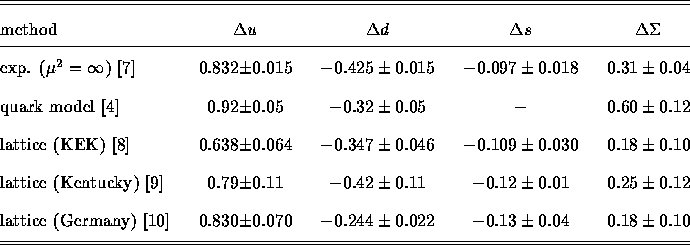


Next: Measurements of Spin
Up: The Spin Structure
Previous: The Spin Structure
Spin is one of the most fundamental
properties of the elementary particles such as a mass and intrinsic
symmetries. Since static quark model
succeeded in the explanation of such properties of the baryons,
the spin of the proton has been believed to be carried by the
quarks for long years.
The surprising results of the polarized muon scattering off the polarized
proton target reported by the EMC collaboration [3]
have stimulated both experimental and
theoretical works to elucidate the spin structure of the proton.
The fraction of the proton spin carried by quark,  , was
amazingly small comparing to the canonical expectation
0.60
, was
amazingly small comparing to the canonical expectation
0.60 0.12 [4].
Post-EMC experiments have confirmed the EMC results.
Now precise data not only from proton but also from deuteron
and
0.12 [4].
Post-EMC experiments have confirmed the EMC results.
Now precise data not only from proton but also from deuteron
and  He are available.
It is worth mentioning that theoretical improvements have played very
important role in the understanding of the experimental data.
The Bjorken sum rule has been confirmed to be valid.
The violation of Ellis-Jaffe sum rules for proton and neutron has been
also confirmed.
The measurement of
He are available.
It is worth mentioning that theoretical improvements have played very
important role in the understanding of the experimental data.
The Bjorken sum rule has been confirmed to be valid.
The violation of Ellis-Jaffe sum rules for proton and neutron has been
also confirmed.
The measurement of  for multi-photon production
in pp collision [5]
has rejected large gluon polarization as Altarelli-Stirling [6].
The current best guess on the quark contribution to the proton spin is:
for multi-photon production
in pp collision [5]
has rejected large gluon polarization as Altarelli-Stirling [6].
The current best guess on the quark contribution to the proton spin is:


Current knowledge on the quark polarization in the proton is summarized
in Table ii.

Table ii: Summary of the experimental results and some theoretical
predictions on the quark polarization in the proton.
The problems of the spin structure of the nucleon are;
- the size of gluon polarization inside the nucleon,
 ,
,
- the size of the sea-quark polarization,
 ,
,
- the validity of currently assumed flavor SU(3), and
- small-x extrapolation.
Conventional polarized deep-inelastic scattering
experiments are not sensitive to these problems, since
- photon does not couple to gluon directly,
- photon cannot distinguish anti-quark from quark,
- photon is not sensitive to the flavor but charge, and
- current experiments are all fixed target experiment.
The spin physics program at RHIC will provide
answers to the questions listed above.
The helicity distribution of the gluon can be measured via
the measurement of  for high-
for high- prompt photon production,
and heavy flavor productions.
The anti-quark distribution can be separated in weak boson production.
Since the flavors are almost fixed in
W productions, flavor decomposition of
the spin dependent quark distribution is also possible.
prompt photon production,
and heavy flavor productions.
The anti-quark distribution can be separated in weak boson production.
Since the flavors are almost fixed in
W productions, flavor decomposition of
the spin dependent quark distribution is also possible.



Next: Measurements of Spin
Up: The Spin Structure
Previous: The Spin Structure
Saito Naohito
1997年01月28日 16時48分17秒
 , was
amazingly small comparing to the canonical expectation
0.60
, was
amazingly small comparing to the canonical expectation
0.60 0.12 [4].
Post-EMC experiments have confirmed the EMC results.
Now precise data not only from proton but also from deuteron
and
0.12 [4].
Post-EMC experiments have confirmed the EMC results.
Now precise data not only from proton but also from deuteron
and  He are available.
It is worth mentioning that theoretical improvements have played very
important role in the understanding of the experimental data.
The Bjorken sum rule has been confirmed to be valid.
The violation of Ellis-Jaffe sum rules for proton and neutron has been
also confirmed.
The measurement of
He are available.
It is worth mentioning that theoretical improvements have played very
important role in the understanding of the experimental data.
The Bjorken sum rule has been confirmed to be valid.
The violation of Ellis-Jaffe sum rules for proton and neutron has been
also confirmed.
The measurement of  for multi-photon production
in pp collision [5]
has rejected large gluon polarization as Altarelli-Stirling [6].
The current best guess on the quark contribution to the proton spin is:
for multi-photon production
in pp collision [5]
has rejected large gluon polarization as Altarelli-Stirling [6].
The current best guess on the quark contribution to the proton spin is:






 ,
,
 ,
,
 for high-
for high- prompt photon production,
and heavy flavor productions.
The anti-quark distribution can be separated in weak boson production.
Since the flavors are almost fixed in
W productions, flavor decomposition of
the spin dependent quark distribution is also possible.
prompt photon production,
and heavy flavor productions.
The anti-quark distribution can be separated in weak boson production.
Since the flavors are almost fixed in
W productions, flavor decomposition of
the spin dependent quark distribution is also possible.